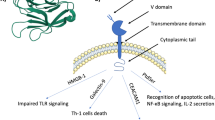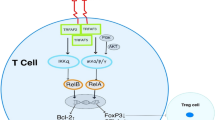Abstract
Invasive ovarian cancer is associated with poor outcome. The presence of infiltrating regulatory T-cells (Tregs) suppresses protective anti-tumor immune responses, and their accumulation into the tumor microenvironment correlates with reduced survival in ovarian cancer patients. Here, we conducted a detailed characterization of CD4+ T-cells, CD8+ T-cells and Treg subsets in the peripheral blood and malignant ascites fluid from seventeen patients with ovarian carcinoma of epithelial origin. Cell distribution, activation status and proliferation status were assessed by multi-color flow cytometry. In ascites fluid, a significant accumulation of CD8+ cytotoxic T-cells and Tregs was observed compared to peripheral blood. Furthermore, a skewing toward the CD45RA− effector/memory compartment was observed in all T-cell subsets in the ascites fluid, but was most pronounced in the Treg population. Regulatory T-cells in the malignant ascites were more activated and had a higher proliferation rate compared to blood-derived cells from the same patient, and their number in ascites was positively correlated with the number of epithelial cells in effusion. In summary, we demonstrate an accumulation of activated CD4+, CD8+ and regulatory T-cells in the cancer microenvironment of ovarian carcinoma.





Similar content being viewed by others
Abbreviations
- CCL17:
-
Chemokine (C–C motif) ligand 17
- CCL22:
-
Chemokine (C–C motive) ligand 22
- CCR4:
-
Chemokine (C–C motive) receptor 4
- CTLA4:
-
Cytotoxic T-lymphocyte-associated protein 4
- EpCAM:
-
Epithelial cell adhesion molecule
- FIGO:
-
International Federation of Gynaecology and Obstetrics
- FoxP3:
-
Forkhead box P3
- IDO:
-
Indoleamine 2,3-dioxygenase
- Ki-67:
-
Marker of proliferation Ki-67
- MHC:
-
Major histocompatibility complex
- PBMC:
-
Peripheral blood mononuclear cells
- PBS:
-
Phosphate buffered saline
- PD1:
-
Programmed cell death 1
- TALs:
-
Tumor-associated lymphocytes
- TILs:
-
Tumor-infiltrating lymphocytes
- Treg:
-
Regulatory T-cell
References
Boyle P, Levin B (eds) (2008) World cancer report 2008. International Agency for Research on Cancer, Lyon
Morgan RJ Jr, Alvarez RD, Armstrong DK, Boston B, Burger RA, Chen LM, Copeland L, Crispens MA, Gershenson D, Gray HJ, Grigsby PW, Hakam A, Havrilesky LJ, Johnston C, Lele S, Matulonis UA, O’Malley DM, Penson RT, Remmenga SW, Sabbatini P, Schilder RJ, Schink JC, Teng N, Werner TL, National Comprehensive Cancer N (2011) Epithelial ovarian cancer. J Natl Compr Canc Netw 9(1):82–113
Parsons SL, Watson SA, Steele RJ (1996) Malignant ascites. Br J Surg 83(1):6–14
Yu P, Fu YX (2006) Tumor-infiltrating T lymphocytes: friends or foes? Lab Invest 86(3):231–245. doi:10.1038/labinvest.3700389
Nelson BH (2008) The impact of T-cell immunity on ovarian cancer outcomes. Immunol Rev 222:101–116. doi:10.1111/j.1600-065X.2008.00614.x
Zhang L, Conejo-Garcia JR, Katsaros D, Gimotty PA, Massobrio M, Regnani G, Makrigiannakis A, Gray H, Schlienger K, Liebman MN, Rubin SC, Coukos G (2003) Intratumoral T cells, recurrence, and survival in epithelial ovarian cancer. N Engl J Med 348(3):203–213. doi:10.1056/NEJMoa020177
Raspollini MR, Castiglione F, Rossi Degl’innocenti D, Amunni G, Villanucci A, Garbini F, Baroni G, Taddei GL (2005) Tumour-infiltrating gamma/delta T-lymphocytes are correlated with a brief disease-free interval in advanced ovarian serous carcinoma. Ann Oncol 16(4):590–596. doi:10.1093/annonc/mdi112
Sato E, Olson SH, Ahn J, Bundy B, Nishikawa H, Qian F, Jungbluth AA, Frosina D, Gnjatic S, Ambrosone C, Kepner J, Odunsi T, Ritter G, Lele S, Chen YT, Ohtani H, Old LJ, Odunsi K (2005) Intraepithelial CD8+ tumor-infiltrating lymphocytes and a high CD8+/regulatory T cell ratio are associated with favorable prognosis in ovarian cancer. Proc Natl Acad Sci USA 102(51):18538–18543. doi:10.1073/pnas.0509182102
Leffers N, Gooden MJ, de Jong RA, Hoogeboom BN, ten Hoor KA, Hollema H, Boezen HM, van der Zee AG, Daemen T, Nijman HW (2009) Prognostic significance of tumor-infiltrating T-lymphocytes in primary and metastatic lesions of advanced stage ovarian cancer. Cancer Immunol Immunother 58(3):449–459. doi:10.1007/s00262-008-0583-5
Barnett JC, Bean SM, Whitaker RS, Kondoh E, Baba T, Fujii S, Marks JR, Dressman HK, Murphy SK, Berchuck A (2010) Ovarian cancer tumor infiltrating T-regulatory (T(reg)) cells are associated with a metastatic phenotype. Gynecol Oncol 116(3):556–562. doi:10.1016/j.ygyno.2009.11.020
Hamanishi J, Mandai M, Iwasaki M, Okazaki T, Tanaka Y, Yamaguchi K, Higuchi T, Yagi H, Takakura K, Minato N, Honjo T, Fujii S (2007) Programmed cell death 1 ligand 1 and tumor-infiltrating CD8+ T lymphocytes are prognostic factors of human ovarian cancer. Proc Natl Acad Sci USA 104(9):3360–3365. doi:10.1073/pnas.0611533104
Adams SF, Levine DA, Cadungog MG, Hammond R, Facciabene A, Olvera N, Rubin SC, Boyd J, Gimotty PA, Coukos G (2009) Intraepithelial T cells and tumor proliferation: impact on the benefit from surgical cytoreduction in advanced serous ovarian cancer. Cancer 115(13):2891–2902. doi:10.1002/cncr.24317
Curiel TJ, Coukos G, Zou L, Alvarez X, Cheng P, Mottram P, Evdemon-Hogan M, Conejo-Garcia JR, Zhang L, Burow M, Zhu Y, Wei S, Kryczek I, Daniel B, Gordon A, Myers L, Lackner A, Disis ML, Knutson KL, Chen L, Zou W (2004) Specific recruitment of regulatory T cells in ovarian carcinoma fosters immune privilege and predicts reduced survival. Nat Med 10(9):942–949. doi:10.1038/nm1093
Zou W (2006) Regulatory T cells, tumour immunity and immunotherapy. Nat Rev Immunol 6(4):295–307. doi:10.1038/nri1806
Miyara M, Yoshioka Y, Kitoh A, Shima T, Wing K, Niwa A, Parizot C, Taflin C, Heike T, Valeyre D, Mathian A, Nakahata T, Yamaguchi T, Nomura T, Ono M, Amoura Z, Gorochov G, Sakaguchi S (2009) Functional delineation and differentiation dynamics of human CD4+ T cells expressing the FoxP3 transcription factor. Immunity 30(6):899–911. doi:10.1016/j.immuni.2009.03.019
Solstad T, Bains SJ, Landskron J, Aandahl EM, Thiede B, Tasken K, Torgersen KM (2011) CD147 (Basigin/Emmprin) identifies FoxP3+CD45RO+CTLA4+-activated human regulatory T cells. Blood 118(19):5141–5151. doi:10.1182/blood-2011-02-339242
Gobert M, Treilleux I, Bendriss-Vermare N, Bachelot T, Goddard-Leon S, Arfi V, Biota C, Doffin AC, Durand I, Olive D, Perez S, Pasqual N, Faure C, Ray-Coquard I, Puisieux A, Caux C, Blay JY, Menetrier-Caux C (2009) Regulatory T cells recruited through CCL22/CCR4 are selectively activated in lymphoid infiltrates surrounding primary breast tumors and lead to an adverse clinical outcome. Cancer Res 69(5):2000–2009. doi:10.1158/0008-5472.CAN-08-2360
Li X, Ye DF, Xie X, Chen HZ, Lu WG (2005) Proportion of CD4+CD25+ regulatory T cell is increased in the patients with ovarian carcinoma. Cancer Invest 23(5):399–403
Liu VC, Wong LY, Jang T, Shah AH, Park I, Yang X, Zhang Q, Lonning S, Teicher BA, Lee C (2007) Tumor evasion of the immune system by converting CD4+CD25− T cells into CD4+CD25+ T regulatory cells: role of tumor-derived TGF-beta. J Immunol 178(5):2883–2892
Zhao X, Ye F, Chen L, Lu W, Xie X (2009) Human epithelial ovarian carcinoma cell-derived cytokines cooperatively induce activated CD4+CD25−CD45RA+ naive T cells to express forkhead box protein 3 and exhibit suppressive ability in vitro. Cancer Sci 100(11):2143–2151. doi:10.1111/j.1349-7006.2009.01286.x
Mahic M, Yaqub S, Johansson CC, Tasken K, Aandahl EM (2006) FOXP3+CD4+CD25+ adaptive regulatory T cells express cyclooxygenase-2 and suppress effector T cells by a prostaglandin E2-dependent mechanism. J Immunol 177(1):246–254
Mahic M, Yaqub S, Bryn T, Henjum K, Eide DM, Torgersen KM, Aandahl EM, Tasken K (2008) Differentiation of naive CD4+ T cells into CD4+CD25+FOXP3+ regulatory T cells by continuous antigen stimulation. J Leukoc Biol 83(5):1111–1117. doi:10.1189/jlb.0507329
Yaqub S, Henjum K, Mahic M, Jahnsen FL, Aandahl EM, Bjornbeth BA, Tasken K (2008) Regulatory T cells in colorectal cancer patients suppress anti-tumor immune activity in a COX-2 dependent manner. Cancer Immunol Immunother 57(6):813–821. doi:10.1007/s00262-007-0417-x
Bhardwaj N (2007) Harnessing the immune system to treat cancer. J Clin Invest 117(5):1130–1136. doi:10.1172/JCI32136
Dong HP, Kleinberg L, Davidson B, Risberg B (2008) Methods for simultaneous measurement of apoptosis and cell surface phenotype of epithelial cells in effusions by flow cytometry. Nat Protoc 3(6):955–964
Bamias A, Tsiatas ML, Kafantari E, Liakou C, Rodolakis A, Voulgaris Z, Vlahos G, Papageorgiou T, Tsitsilonis O, Bamia C, Papatheodoridis G, Politi E, Archimandritis A, Antsaklis A, Dimopoulos MA (2007) Significant differences of lymphocytes isolated from ascites of patients with ovarian cancer compared to blood and tumor lymphocytes. Association of CD3+CD56+ cells with platinum resistance. Gynecol Oncol 106(1):75–81. doi:10.1016/j.ygyno.2007.02.029
Acknowledgments
We thank the pathologists from the Department of Pathology, The Gade Institute, Haukeland University Hospital, Bergen, Norway for routine histopathological diagnosis of the tumor specimens. Furthermore, we thank Isabelle Cornez, Kristoffer W. Brudvik and Simer J. Bains for help with processing samples for subsequent analysis. This work was supported by the Research Council of Norway, the Norwegian Cancer Society, the Kristian Gerhard Jebsen Foundation and Anders Jahre’s Foundation.
Conflict of interest
The authors declare no conflict of interest.
Author information
Authors and Affiliations
Corresponding author
Electronic supplementary material
Below is the link to the electronic supplementary material.
Rights and permissions
About this article
Cite this article
Landskron, J., Helland, Ø., Torgersen, K.M. et al. Activated regulatory and memory T-cells accumulate in malignant ascites from ovarian carcinoma patients. Cancer Immunol Immunother 64, 337–347 (2015). https://doi.org/10.1007/s00262-014-1636-6
Received:
Accepted:
Published:
Issue Date:
DOI: https://doi.org/10.1007/s00262-014-1636-6




